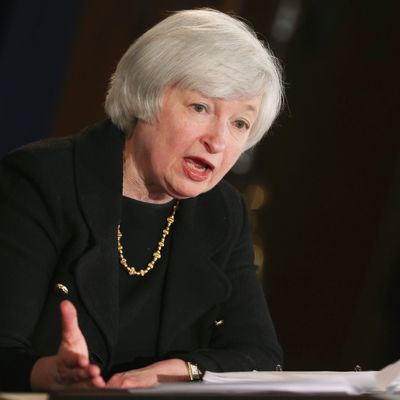
This morning, Janet Yellen, the chair of the Federal Reserve, did something rare for a central banker: She devoted a speech to inequality.
Speaking in Boston, Yellen flatly announced, “The extent of and continuing increase in inequality in the United States greatly concern me.” She went on to say: “It is no secret that the past few decades of widening inequality can be summed up as significant income and wealth gains for those at the very top and stagnant living standards for the majority. I think it is appropriate to ask whether this trend is compatible with values rooted in our nation’s history, among them the high value Americans have traditionally placed on equality of opportunity.”
The economics in her speech are hardly controversial. She ran through some well-worn numbers on small business creation and higher education and wealth. But the charged nature of the topic was unusual, and Yellen immediately got some backlash for politicizing the Fed. There was a second stream of criticism, too: Wasn’t Yellen bemoaning inequality that she and other central bankers helped to create, as posited by Lawrence McDonald, Charles Gasparino, and many others?
Here’s the argument. Since the financial crisis hit, the Federal Reserve has slashed interest rates and engaged in round after round of quantitative easing, buying up hundreds of billions of dollars of assets in order to spur investors to invest.
One effect has been to lift asset prices, particularly for stocks and bonds — thus boosting the wealth of asset-holders. And who are the asset holders? Mostly rich people. The top 20 percent of the wealth distribution owns more than 90 percent of financial assets, as measured by value. The top one percent alone own one third of all stocks and mutual funds, one third of all non-home real estate, one third of all trusts, two thirds of all financial securities, and two thirds of all business equity.
Furthermore, the Fed has helped to buoy the housing market by buying mortgage-backed securities as part of its quantitative easing campaign. That made it cheaper for families to buy a house or to refinance their existing loans. But because of tight credit standards, that windfall mostly aided the rich, too.
In that sense, the Fed’s policies have intensified income and wealth inequality. But I fear that reading is too simplistic. The Fed’s policies have also hurt the earnings of some wealthier families — pensioners come to mind — by reducing yields and interest rates. Much more important, the Fed’s campaign has helped to increase growth and reduce unemployment overall, thus helping to hold up wages and boost earnings at the lower end of the income spectrum. That raises the prospect that the rich have benefited more than the poor, but not at the expense of the poor.
“The effect is going to be at the margin if it is there at all,” Joseph Gagnon, a former Fed economist, told me last year when I asked him if the Fed was stoking inequality. “It’s kind of a silly question to ask, though. It’s relevant to talk about international trade. It’s relevant to talk about technology. It’s relevant to talk about regulation. Monetary policy seems far down the list.”
The math is going to be complicated one way or another, and no economist, to my knowledge, has ever attempted a complete look at the distributional effects of the Fed’s unusual policies since the recession hit. Perhaps Yellen knows a few who might be able to help?





























